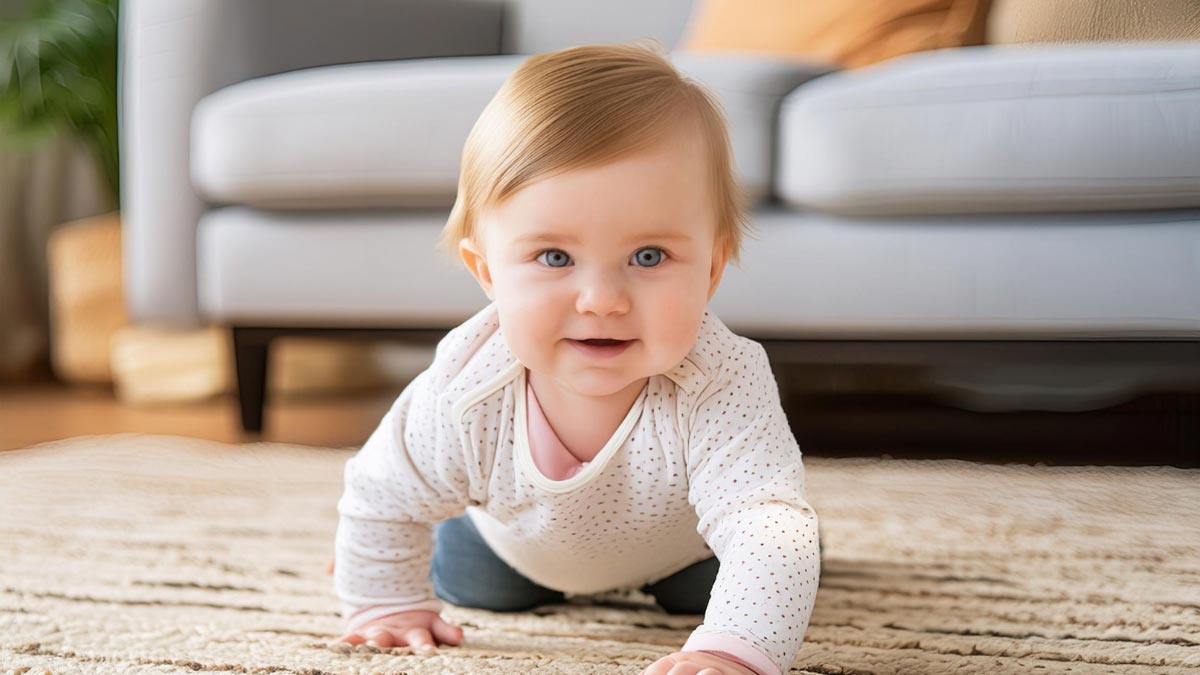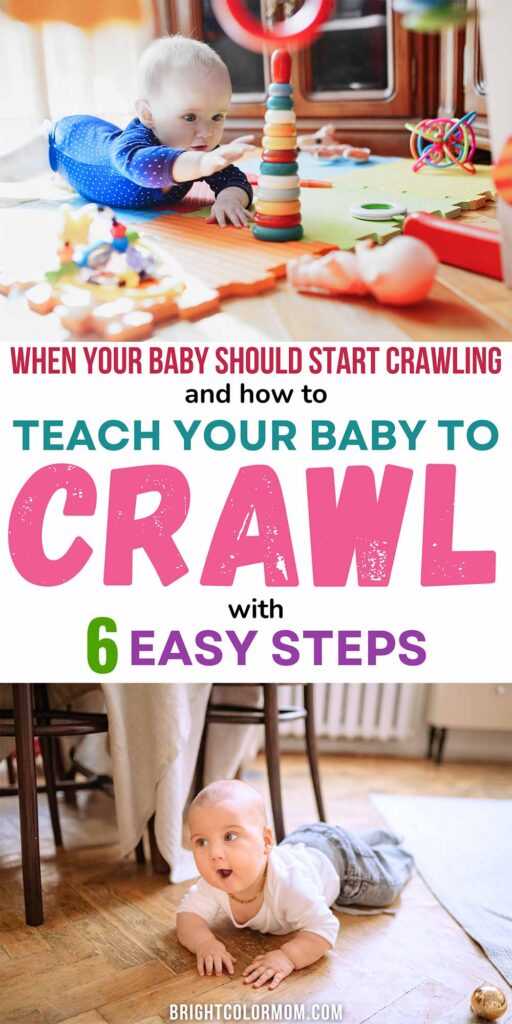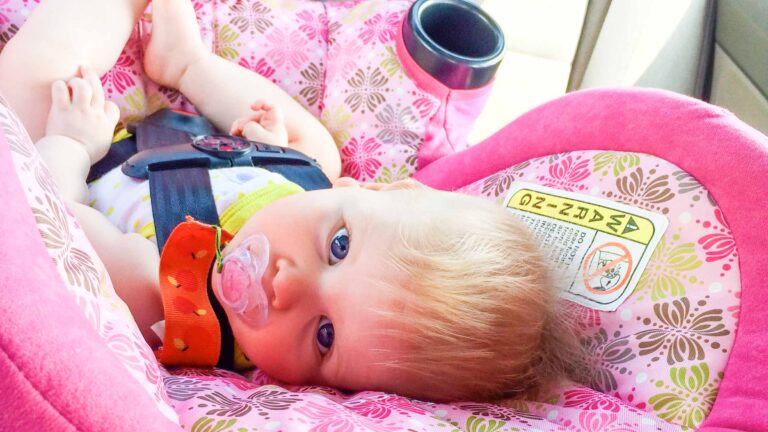Let’s face it: watching your baby crawl for the first time is pure magic. It’s a win for them and a big moment for you. Crawling strengthens motor skills, coordination, and problem-solving abilities while fueling their insatiable desire to explore every nook and cranny of your house. But when do babies start crawling? And is it actually that important? I’ll answer all your questions and reassure you that your baby is doing just fine.
When Crawling Starts
Most babies conquer crawling sometime between 7 and 12 months old, with many reaching this milestone closer to 9 months.
Don’t worry, I get it – it feels like forever when you’re waiting for those first wobbly steps. With both of my babies, I felt like they were behind on crawling. They were actually right on schedule, either scooting backward (Lily) or army crawling (Hugo) at 7.5 months. Regular crawling came about a month later for both!
And this is just a general timeframe. Every baby develops at their own pace, and some may surprise you by crawling a little earlier or later. Think of it like a personal best they’re training for – and you’re their enthusiastic cheerleader!
Pre-Crawling Skills
Before your mini-explorer embarks on their crawling adventure, they need to master some key skills.
Head and Neck Control (around 3-4 months)
This lets them hold their head steady during tummy time. Think of them as tiny weightlifters, strengthening those neck muscles.
Rolling Over (around 4-6 months)
Mastering rolling paves the way for crawling by building core muscles and coordination. Basically, they’re practicing their escape plan for the crib.
Sitting Up Independently (around 6-8 months)
This milestone strengthens back and neck muscles crucial for crawling. Soon, they’ll be little pros at sitting up and surveying their kingdom (a.k.a. your living room). Keep in mind they might be crawling before they can sit up (my son couldn’t sit until 9 months, but he was crawling everywhere)!
Crawling Styles
Forget the myth of the “perfect” crawl! Babies are unique, and their crawling styles reflect that. Here are some common variations, all perfectly normal.
- The Classic: Hands and knees crawling, just like you imagine.
- The Commando: Your baby might scoot on their belly while using their arms for propulsion. Think army crawl, but way cuter.
- The Scoot: Some scoot on their bottoms, pushing off with their legs. It might not be the most graceful, but hey, it gets the job done!
- The Backward Crawler: Don’t be surprised if your baby explores in reverse before mastering the forward motion. They’re just keeping you on your toes (literally!).
The transition between styles can be fluid. Your baby might experiment with different techniques before finding their favorite way to move.
Signs Your Baby’s Getting Ready to Crawl
Get ready to cheer – these signs indicate crawling is on the horizon!
- Rocking Back and Forth: This rocking motion on their hands and knees strengthens the core muscles needed for crawling. Think of it as their pre-crawl warm-up.
- Pushing Up on Arms: Notice your baby pushing up on their arms with a straight back while on their tummy? This shows they’re developing the upper body strength for crawling.
- Reaching for Toys: A natural desire to explore! When your baby reaches for toys with both hands while on their tummy, it demonstrates their coordination and interest in getting mobile.
You can track your baby’s crawling progress by noting when they achieve each pre-crawling milestone and their attempts at different crawling styles.
Variations in Development
Every baby crawls at their own pace, literally. And some skip it entirely and go straight to walking! Here are some factors that could delay reaching this milestone.
- Not Enough Floor Time: Think jungle gym, not bouncer. Babies need space to explore and practice movement.
- Carry On? Maybe Not: Lots of time in carriers, swings, or Mom’s arms might delay crawling milestones. Floor time is key for building those muscles.
- Swaddle Trouble: Swaddling is great, but too much can limit the leg and core strength needed for crawling.
Not crawling by 12 months and not scooting or pulling up either? Talk to your pediatrician. They can check things out and ease your mind.
This post may contain affiliate links. If you make a purchase after clicking one, I may receive a small commission at no cost to you.
Tips to Encourage Crawling
Now that you know the basics, let’s get your baby crawling!
Clear the Runway
Pick up floor clutter and try to create a large, open floor space. Make sure there’s nothing to stop them.
Make Things Comfy
If you don’t have a clean area rug to lay your baby on, provide a soft play mat or blanket to crawl on.
Babyproof
Move the dangerous things you can, and cover up the dangerous things you can’t. Block off stairways and rooms you don’t want them crawling into.
Tummy Time
This crucial activity strengthens all the pre-crawling muscles. Aim for at least 20 minutes of tummy time spread throughout the day, starting from birth. Here are some tips to make it less of a chore and more of a positive experience.
Prop Them Up
For babies not yet holding themselves up, use rolled-up towels or blankets to create an incline, encouraging them to push up with their arms. Think mini push-ups! You can also get a pillow made for tummy time with toys hanging off the front to keep your baby engaged.
Engage with Toys
When they’re not propped up, place colorful, stimulating toys just out of reach to entice them to reach and stretch. It’s like baby yoga but with way less spandex.
Change Positions
Vary tummy time by placing your baby on their side or with their head facing down. This works different muscle groups, making them even stronger little explorers.
Crawling Games
- Temptation: Put a favorite toy just out of reach – motivation to crawl engaged!
- Mirror, Mirror: A large, safe mirror on the floor is captivating for tummy time and encourages reaching.
- Tunnel Vision: A soft play tunnel adds a fun twist to crawling adventures.
Toys for Aspiring Crawlers
These toys are designed to get your baby moving by enticing them to chase or helping them get going. I found great success with the VTech ball. Its movements are unpredictable, keeping your baby intrigued and eager to get their hands on it.
These are just a few ideas. The key is to create a safe and stimulating space that sparks your baby’s natural curiosity and desire to move.
Crawling on Their Own Time
Crawling is a big deal, but remember, every baby hits milestones at their own pace. The 7-12 month timeframe is a suggestion, not a rule. The CDC doesn’t even consider crawling a set milestone! This makes sense since we all prefer walking around to crawling everywhere. Crawling doesn’t seem so important when you put it in perspective.
Focus on creating a safe and fun space with plenty of tummy time, and watch your little explorer develop. Celebrate every wiggle, rock, and scoot – they’re all part of their amazing journey!
















